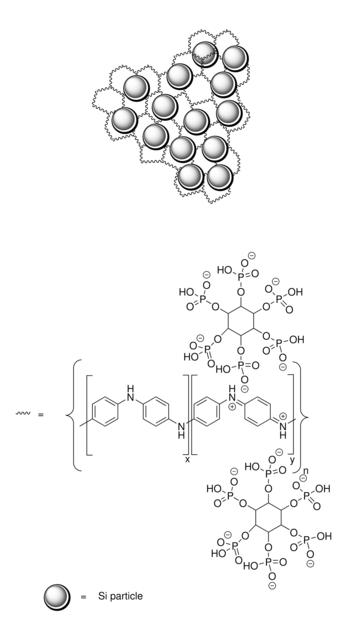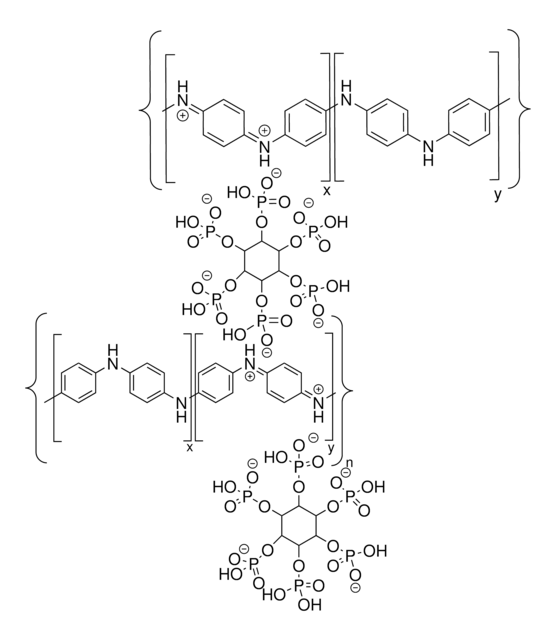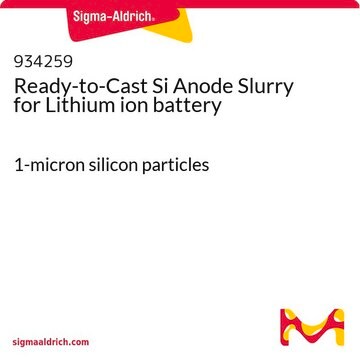Alle Fotos(1)
Wichtige Dokumente
912409
High-performance silicon anode
1 micron silicon particles in crosslinked conducting polyanaline matrix
Synonym(e):
Doped polyaniline, Si encapsulated in 3D crosslinked polyaniline, Si/PANi composite, Silicon micron particle
Anmeldenzur Ansicht organisationsspezifischer und vertraglich vereinbarter Preise
Alle Fotos(1)
About This Item
UNSPSC-Code:
12352103
NACRES:
NA.23
Empfohlene Produkte
Qualitätsniveau
Form
solid
Suchen Sie nach ähnlichen Produkten? Aufrufen Leitfaden zum Produktvergleich
Anwendung
Silicon is a most promising next generation lithium ion battery electrode material, due to its ~10 times higher specific capacity (3600 mAh/g) than graphite (372 mAh/g). However, silicon experiences large volume change (~400%) during lithium insertion, causing it to fracture and detach from current collector, rendering prototypical lithium-silicon batteries to lose most of their capacity in less than 10 charge-discharge cycles. A solution to the capacity and stability issues posed by the significant volume expansion upon lithiation of silicon is critical to the success of high capacity lithium ion batteries.
This silicon/PANi composite utilizes a doped, intrinsically conductive, 3D cross-linked polyaniline as matrix, which could function as both the conductive binder and the polymer electrolyte for silicon-based electrodes. Previous study for a similar silicon-based three-dimensional conducting polymer composite demonstrated increased electrochemically performance due to short diffusion paths and good 3D connectivity, and resulted in a marked improvement in cyclability, with over 90% capacity retention after 5,000 cycles.
This composite is made by encapsulating silicon particles in an in-situ polymerized 3D-crosslinked conductive polyaniline framework. This Si/PANi composite not only allows fast electrical and ionic transport, but also provides free space to allow giant volume expansion. This Si/PANi composite provides a ready-to-use electrochemically active silicon composite that would increase the capacity of conventional lithium ion battery, and improve the cycle-life of Si-based anodes.
This silicon/PANi composite utilizes a doped, intrinsically conductive, 3D cross-linked polyaniline as matrix, which could function as both the conductive binder and the polymer electrolyte for silicon-based electrodes. Previous study for a similar silicon-based three-dimensional conducting polymer composite demonstrated increased electrochemically performance due to short diffusion paths and good 3D connectivity, and resulted in a marked improvement in cyclability, with over 90% capacity retention after 5,000 cycles.
This composite is made by encapsulating silicon particles in an in-situ polymerized 3D-crosslinked conductive polyaniline framework. This Si/PANi composite not only allows fast electrical and ionic transport, but also provides free space to allow giant volume expansion. This Si/PANi composite provides a ready-to-use electrochemically active silicon composite that would increase the capacity of conventional lithium ion battery, and improve the cycle-life of Si-based anodes.
Lagerklassenschlüssel
11 - Combustible Solids
WGK
WGK 3
Flammpunkt (°F)
Not applicable
Flammpunkt (°C)
Not applicable
Hier finden Sie alle aktuellen Versionen:
Analysenzertifikate (COA)
Lot/Batch Number
Leider sind derzeit keine COAs für dieses Produkt online verfügbar.
Wenn Sie Hilfe benötigen, wenden Sie sich bitte an Kundensupport
Besitzen Sie dieses Produkt bereits?
In der Dokumentenbibliothek finden Sie die Dokumentation zu den Produkten, die Sie kürzlich erworben haben.
Deformation and stress in electrode materials for Li-ion batteries.
Mukhopadhyay A, et al.
Progress in Materials Science, 63, 58-116 (2014)
Hui Wu et al.
Nature communications, 4, 1943-1943 (2013-06-05)
Silicon has a high-specific capacity as an anode material for Li-ion batteries, and much research has been focused on overcoming the poor cycling stability issue associated with its large volume changes during charging and discharging processes, mostly through nanostructured material
Ye Shi et al.
Advanced materials (Deerfield Beach, Fla.), 29(22) (2017-03-23)
This study develops a tunable 3D nanostructured conductive gel framework as both binder and conductive framework for lithium ion batteries. A 3D nanostructured gel framework with continuous electron pathways can provide hierarchical pores for ion transport and form uniform coatings
Fei Zhao et al.
Advanced materials (Deerfield Beach, Fla.), 30(48), e1801796-e1801796 (2018-08-21)
Nanostructured materials are critically important in many areas of technology because of their unusual physical/chemical properties due to confined dimensions. Owing to their intrinsic hierarchical micro-/nanostructures, unique chemical/physical properties, and tailorable functionalities, hydrogels and their derivatives have emerged as an
Ye Shi et al.
Nano letters, 17(3), 1906-1914 (2017-02-14)
Controlling architecture of electrode composites is of particular importance to optimize both electronic and ionic conduction within the entire electrode and improve the dispersion of active particles, thus achieving the best energy delivery from a battery. Electrodes based on conventional
Unser Team von Wissenschaftlern verfügt über Erfahrung in allen Forschungsbereichen einschließlich Life Science, Materialwissenschaften, chemischer Synthese, Chromatographie, Analytik und vielen mehr..
Setzen Sie sich mit dem technischen Dienst in Verbindung.






